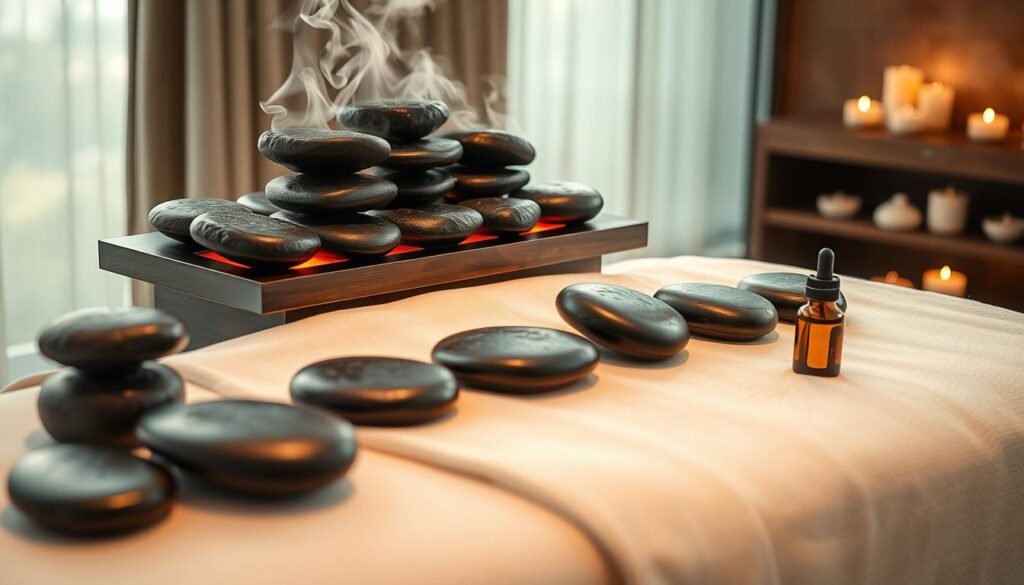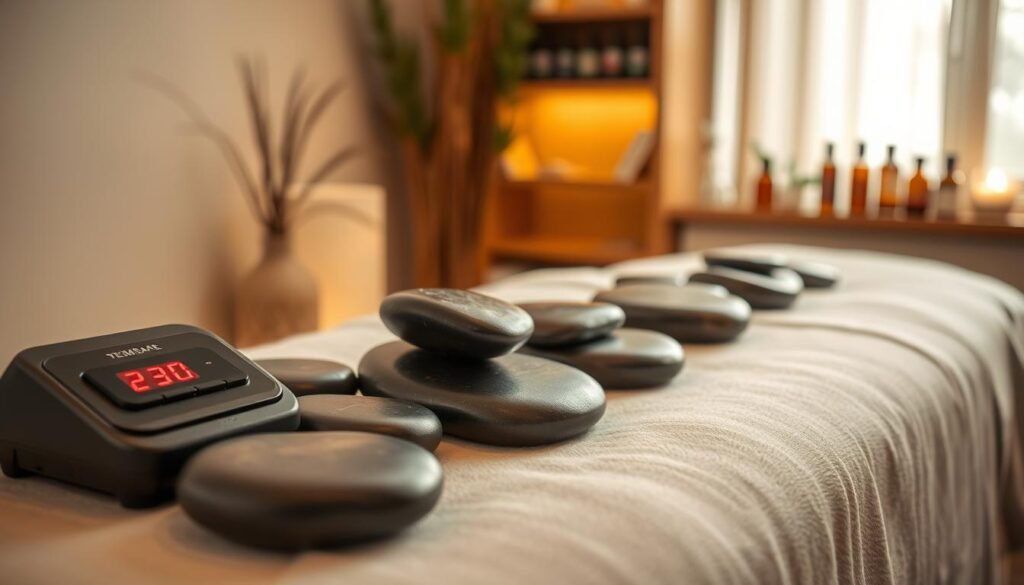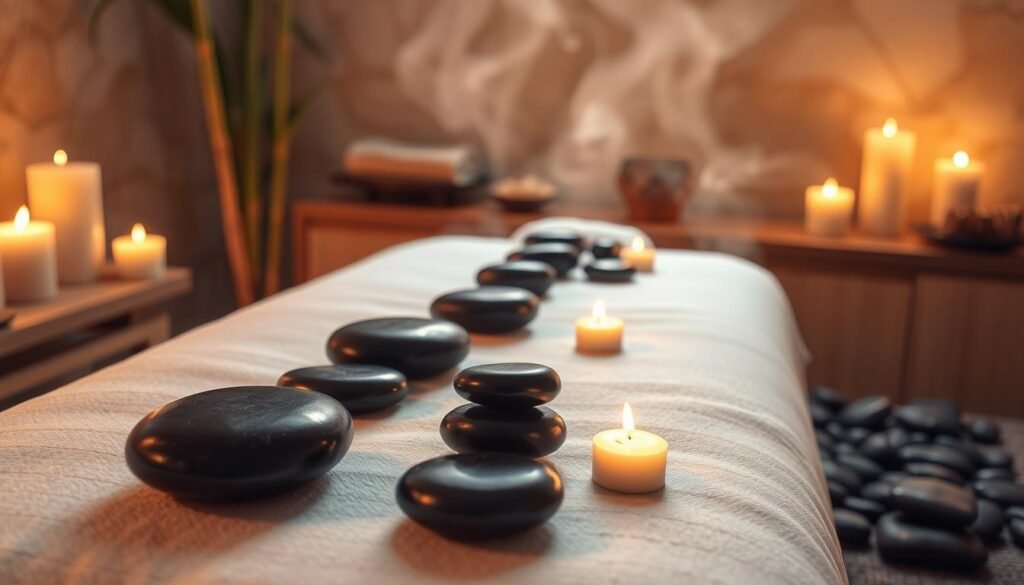Ever wondered why hot stone massage feels so amazing? This ancient therapy combines warmth and touch to release tension. In this guide, I’ll share the basics of hot stone massage techniques, therapy, and safety.
Hot stone massage is more than just warm rocks on your body. It’s an art that needs skill, knowledge, and understanding of the body. Choosing the right stones and finding the perfect temperature are key to a safe and effective treatment.
Exploring hot stone massage, you’ll see why heating stones right is vital. Safety is top priority, and I’ll give you tips for a worry-free experience. This guide will improve your hot stone massage skills, whether you’re experienced or new.
Key Takeaways
- Hot stone massage combines warmth and touch for deep relaxation
- Proper stone selection and heating are crucial for effective therapy
- Safety precautions are essential in hot stone massage practice
- Mastering temperature control enhances the massage experience
- Understanding the history and benefits of hot stone therapy improves technique
Understanding Hot Stone Massage Therapy
Hot stone massage therapy combines ancient healing with modern methods. It offers a deeply relaxing and therapeutic experience. Let’s dive into its history, principles, and benefits.
Origins and History
Hot stone massage has a long history across cultures. Ancient Indians, Chinese, and Native American tribes used heated stones for healing. The modern version started in the 1990s, making it popular in spas worldwide.
Basic Principles of Hot Stone Massage
The heart of hot stone massage is using smooth, heated basalt stones. These stones keep heat well, helping relax muscles deeply. Therapists place stones on key points and use them as massage tools, blending warmth with pressure.
Benefits for Clients
Hot stone massage offers many benefits. Clients often see:
- Reduced muscle tension and pain
- Improved circulation
- Less stress and anxiety
- Better sleep quality
- Relief from fibromyalgia and arthritis symptoms
This therapy enhances relaxation and addresses physical discomfort. As a practitioner, I’ve seen it transform clients’ well-being. It provides immediate relief and long-term health benefits.
Essential Equipment for Hot Stone Massage

Having the right equipment is key for a great hot stone massage. Let’s look at the must-haves for your toolkit.
First, you need smooth basalt stones. These volcanic rocks come in sizes from egg to palm. Their flat sides are great for skin contact. I keep a variety to cover all body areas.
A stone heater is a must. It keeps the stones at the right temperature. Safety first, so I always check with a thermometer before using them.
Quality massage oil or lotion is crucial. It makes the stones move smoothly and improves the experience. I choose unscented ones for sensitive clients.
Soft towels and sheets are needed for comfort and stone placement. I also have tongs for handling hot stones safely.
| Equipment | Purpose | Importance |
|---|---|---|
| Basalt Stones | Main massage tool | Essential |
| Stone Heater | Maintain stone temperature | Critical |
| Thermometer | Safety check | Vital |
| Massage Oil | Smooth application | Important |
| Towels/Sheets | Client comfort | Necessary |
With these key items, I’m ready to give my clients a safe, effective, and relaxing massage.
Proper Stone Selection and Preparation
In hot stone massage, picking the right stones is key. I’ll show you the best stones, how to clean them, and their sizes. This ensures a safe and great massage.
Types of Stones Used
Basalt stones are the top choice for hot stone massage. They hold heat well, making them ideal for warming the body. Their smooth surface also makes the massage better.
Cleaning and Sanitizing Stones
Cleaning stones is very important. I clean and sanitize them after each use. Here’s how I do it:
- Wash stones with mild soap and warm water
- Rinse them well to get rid of soap
- Sanitize with a strong disinfectant
- Let them air dry before using them again
Stone Size and Shape Considerations
The size and shape of stones matter a lot. I use different stones for different things:
| Stone Type | Size | Shape | Use |
|---|---|---|---|
| Placement Stones | Large | Flat | Static placement on body |
| Massage Stones | Small to Medium | Round | Active massage techniques |
| Facial Stones | Very Small | Oval | Delicate facial work |
I check each stone before a session for any damage. This ensures the massage is safe and effective.
How to Heat Hot Stone Massage Safely

Heating stones safely is key for a great hot stone massage. I’ll show you how to do it right. This way, you’ll keep your clients safe and comfortable.
Choosing the Right Heating Device
For the best results, use a professional massage stone heater. Don’t use microwaves, hot plates, or slow cookers. They can heat unevenly or too much. A proper heater keeps the stones at the right temperature.
Temperature Control and Monitoring
The water should be between 110°F and 130°F (43°C to 54°C). Use a thermometer to check the temperature. Make sure stones are fully submerged for even heating.
Safety Precautions
Always test the stone’s temperature before using it on clients. Hold a stone for five seconds; if it’s too hot, it’s not safe. Use a towel or sheet to protect the client’s skin. Keep checking and adjusting the water temperature during the massage.
- Use professional heaters only
- Monitor water temperature with a thermometer
- Test stones before applying to clients
- Use barriers between stones and skin
- Regularly check and adjust temperature
By following these steps, you’ll make sure your clients have a safe and enjoyable massage. Their comfort and safety will be your top priority.
Techniques for Applying Hot Stones

I’ve learned many hot stone massage techniques over the years. These methods help people relax and heal. Let’s look at the main ways this therapy works.
Stone placement is a key technique. I place heated stones on certain body points. These include the back, stomach, hands, feet, and face. A barrier keeps the stone safe and comfortable against the skin.
Gliding stones over oiled skin is another good method. The stones act like my hands, allowing deep tissue work. It takes skill to keep the right pressure and temperature.
Stone Temperature Management
Keeping an eye on stone temperature is very important. I use a special thermometer to check often. This makes sure clients are safe and get the best benefits.
| Body Area | Recommended Stone Temperature | Duration of Placement |
|---|---|---|
| Back | 120-130°F (49-54°C) | 5-10 minutes |
| Hands/Feet | 110-120°F (43-49°C) | 3-5 minutes |
| Face | 100-110°F (38-43°C) | 2-3 minutes |
Adjusting hot stone massage techniques for each person is crucial. I think about what the client likes, their health, and what they want to get from the massage. This makes sure each massage is the best it can be for the client.
Integrating Hot Stones with Massage Techniques
Hot stone massage therapy is a mix of relaxation and healing. Combining hot stones with traditional massage techniques makes it even more powerful. Let’s see how to do it well.
Combining with Swedish Massage
Swedish massage is the base for many hot stone techniques. I put heated stones on key body areas. Then, I use long strokes to spread warmth and relax muscles.
Using Stones for Deep Tissue Work
For deep tissue work, I use stones to warm up tight muscles. This lets me apply deeper pressure without hurting. I use smaller stones for specific tension spots, working out knots better.
Stone Placement Strategies
Where you place stones is key in hot stone massage. I usually put stones along the spine, on palms, and between toes. This layout balances energy flow and targets major muscles. Here’s a list of common spots:
| Body Area | Stone Type | Benefits |
|---|---|---|
| Spine | Large flat stones | Relaxes back muscles, improves posture |
| Palms | Small round stones | Relieves hand tension, promotes relaxation |
| Between toes | Tiny smooth stones | Enhances grounding, stimulates reflexology points |
By mixing these techniques, I make a massage that meets each client’s needs. This way, both traditional massage and hot stone therapy work better together.
Client Care and Communication
In hot stone massage sessions, client care and communication are key. I focus on these to make sure my clients are comfortable and informed. This makes their experience positive.
Pre-session Consultations
I start with thorough pre-session consultations. I fill out a detailed intake form to know about the client’s health. I ask about their medical history, current medications, and any areas of concern.
Explaining the Process to Clients
I take time to explain the hot stone massage process. I talk about stone temperature, placement, and techniques. I stress the importance of client feedback to ensure their comfort and safety.
Addressing Client Concerns and Comfort
During the massage, I encourage open communication. I remind clients to speak up if they feel any discomfort. I also give tips on staying hydrated before, during, and after the massage.
| Communication Point | Purpose |
|---|---|
| Pre-session consultation | Gather health information and set expectations |
| Process explanation | Inform clients about the hot stone massage technique |
| Ongoing feedback | Ensure client comfort and adjust as needed |
| Post-session discussion | Address any concerns and provide aftercare advice |
By focusing on clear communication and addressing concerns, I create a safe space. This lets clients relax and enjoy the treatment’s benefits fully.
Contraindications and Precautions
It’s important to know about hot stone massage safety for both those giving and receiving the treatment. This therapy has many benefits, but it’s not for everyone. Here are the main things to watch out for to keep everyone safe.
- High blood pressure
- Diabetes
- Heart disease
- Varicose veins
- Migraines
- Rheumatoid arthritis
- Decreased pain sensitivity
- Recent wounds or skin inflammations
- Tumors
- Metal implants
- Recent chemotherapy, radiation, or surgery
Pregnant women should not get hot stone massage. People taking blood-thinning drugs should talk to their doctor first. Making sure clients are safe is key, and doing a good check before starting is crucial.
| Condition | Reason for Caution | Alternative Recommendation |
|---|---|---|
| High blood pressure | Heat can increase blood flow | Swedish massage without stones |
| Diabetes | Risk of burns due to neuropathy | Gentle touch therapy |
| Pregnancy | Risk of overheating | Prenatal massage techniques |
If you’re not sure if a client can have hot stone massage, it’s better to be safe. Encourage them to talk openly and get a doctor’s okay if needed. By focusing on safety, we can make sure everyone has a good experience.
Enhancing Your Hot Stone Massage Skills
Mastering hot stone massage takes hard work and never-ending learning. Getting specialized training and certifications is key to becoming an expert in this healing art.
Training and Certification Options
Many massage schools have detailed hot stone massage courses. These cover choosing stones, heating them, and how to use them. I got a hot stone massage certification from a well-known place. It made me more confident and helped clients trust me more.
Continuing Education Opportunities
It’s important to keep up with new hot stone massage methods. I go to workshops and seminars to learn new things and stay safe. Online courses also help me grow my knowledge. These chances to learn help me improve and give my clients the best service.
Practicing and Refining Techniques
Practicing often is crucial to get better at hot stone massage. I work on controlling stone temperatures and how I apply them. Getting feedback from clients and others helps me get better. By always working on my skills, I make sure each session is relaxing and beneficial for my clients.
| Skill Enhancement Method | Benefits |
|---|---|
| Hot stone massage certification | Increased credibility and client trust |
| Continuing education workshops | Up-to-date techniques and safety protocols |
| Regular practice sessions | Improved stone handling and temperature control |
| Client feedback | Personalized service and technique refinement |
Incorporating Cold Stones in Hot Stone Therapy
Adding cold stones to hot stone massage can really enhance the treatment. It’s great for both long-term and sudden issues like injuries and swelling. To prepare, I chill the stones in a fridge or ice bucket. I aim for a temperature between room temperature and 25°F (-4°C).
Cold stones are especially useful for targeting trigger points and applying cross-fiber friction. I often alternate between hot and cold stones. This helps reduce swelling and congestion in specific areas. The combination of hot and cold stones can be very effective.
One important tip: I warm my hands before switching from cold to hot stones. This prevents startling my clients with a sudden temperature change. By mixing hot and cold stones, I can offer a more varied and beneficial massage experience.
FAQ
What are the origins of hot stone massage therapy?
What are the benefits of hot stone massage?
What equipment is essential for hot stone massage?
What type of stones are used for hot stone massage, and why?
How do you safely heat stones for hot stone massage?
How are hot stones applied during a massage session?
How are hot stones integrated with other massage techniques?
What client care practices are important for hot stone massage?
Who should avoid hot stone massage therapy?
How can I enhance my hot stone massage skills?
How are cold stones incorporated into hot stone therapy?
Source Links
- The Ultimate Guide to Hot Stone Massage – https://lavidamassagedallasga.com/the-ultimate-guide-to-hot-stone-massage/
- Don’t Feel the Burn: Hot Stone Massage | Massage Therapy Journal – https://www.amtamassage.org/publications/massage-therapy-journal/hot-stone-massage/
- How to Give a Hot Stone Massage – Cortiva Institute – https://www.cortiva.edu/blog/how-to-give-a-hot-stone-massage/













6 Comments
Interesting read, but wouldnt the effectiveness of hot stone massage also depend on the individuals heat tolerance?
Absolutely, its subjective. But isnt every therapeutic practice subjective to individual tolerance?
Interesting read! But does anyone know if heating stones in a microwave could be a possible alternative? Its not mentioned here.
Really interesting read, but isnt heating stones in a slow cooker a potential fire hazard? Safety first, guys!
Does anyone else think that the origins and history section should have included more about cultural contexts? Just a thought.
Interesting read! But, does anyone know if theres a significant difference between basalt and river stones for hot stone massage?